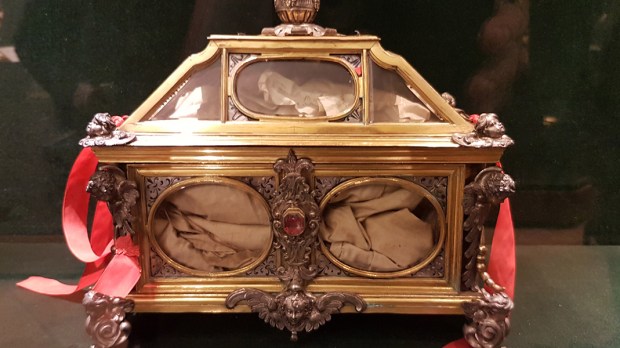Canterbury Cathedral is preparing to celebrate the 850th anniversary of the martyrdom of St. Thomas Becket, one of England’s most revered medieval saints. To honor the occasion, the Vatican has agreed to loan Canterbury a holy relic of the patron saint of the city of London: the bloodied garment he was believed to have worn at the time of his murder.
The Guardian reports that the garment is a religious vestment known as a tunicle, an article of clothing similar in style to a dalmatic, which was worn by a priest over his alb when celebrating Mass. The relic is encased within a 17th-century glass reliquary, which will be on display from July 4 to August 3, 2020.
St. Thomas Becket’s priesthood was notable for his conflicts with English nobility over the Church’s supremacy. As with St. Thomas More, who clashed with King Henry VIII, St. Thomas Becket was at odds with King Henry II, who was at one time a close friend to the martyred saint.
In 1162, Becket was named Archbishop of Canterbury, at which point he became incredibly pious and began preaching against worldly gain. During an 1164 conference between the king and the country’s high clergy, St. Thomas was the only staunch objector who refused to sign the Constitutions of Clarendon, which would have limited the clerical authority of Rome in England. Afterward he was sent into exile on charges of contempt of royal authority and malfeasance in the Chancellor’s office.
He was allowed to return to England in 1170, but he had only been back for a few months before he clashed once more with the nobility. The soon-to-be martyr was upset that the Archbishop of York, the Bishop of London, and the Bishop of Salisbury had crowned Henry the Young King at York. As the Bishop of Canterbury was supposed to be afforded this privilege, Becket excommunicated all three.
It was at this time that King Henry II famously mused, “Will no one rid me of this turbulent priest?” While the accuracy of the statement is argued by scholars, the message the king’s men took was that Thomas must die. On December 29, 1170, four knights entered Canterbury Cathedral and demanded that Becket go to Winchester for judgement, but when he refused they martyred him right in front of the altar.
Church Times notes that the arrival of the relic in Canterbury will coincide with the Lambeth Conference, a decennial assembly of bishops of the Anglican Communion convened by the Archbishop of Canterbury. This year’s theme of the conference will be, “God’s Church for God’s World: walking, listening and witnessing together.” The relic is sure to be a great help to the “witnessing” aspect, as it is expected to draw thousands of pilgrims for prayer and veneration.
The Rev. Max Kramer, Precentor of the cathedral, told Hattie Williams of Church Times:
“We hope that seeing the garment associated with Becket’s death, and being reminded of his extraordinary legacy, will help them to find the strength and encouragement of God as they continue to witness to our shared faith with great courage in difficult times.”

